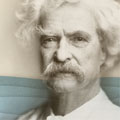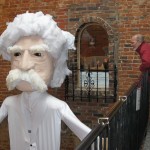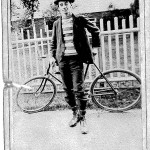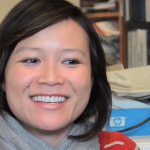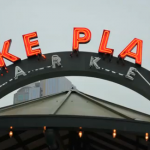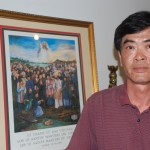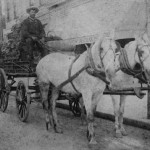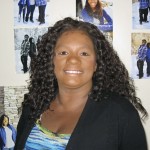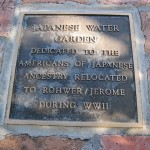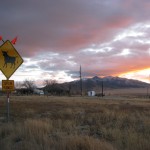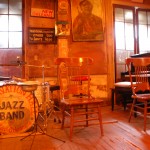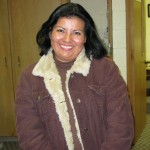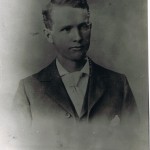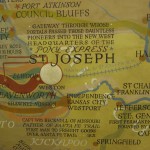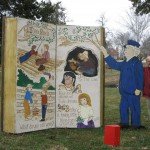Of all the cities and towns on Mark Twain’s route west that we visited, Salt Lake City honors him least.
The city’s magnificent main library, a 240,000-sq.-ft., five-story-tall curved wedge-shaped beauty by Moshe Safdie and other distinguished architects, celebrates a variety of authors. Its café is named for Hemingway, its bookstore features Poe, its newsletter carries Shakespeare on its front page. But Twain is nowhere to be seen.
Am I surprised? No. In a city that invites humor (a local beer, Wasatch Polygamy Porter, advertises “Why have just one!”), Twain took aim at The Church of Jesus Christ of Latter-day Saints or Mormons. He questioned the Mormon Bible (“half modern glibness, and half ancient simplicity and gravity”) and “valley tan,” a whiskey-like invention of Mormons, who were not supposed to drink.
Though he praised the industriousness of Latter-day Saints (“no loafers perceptible”) and their extraordinary health (the town’s lone doctor had few customers), Twain joked about planning to lead a great reform to end polygamy, until he saw Mormon women.
“The man who marries sixty of them,” Twain wrote, “has done a deed of open-handed generosity so sublime that the nation should stand uncovered in his presence and worship in silence.”
Twain also observed that Utah locals, not just Mormons, despised outsider “emigrants” such as Twain—“low and inferior sort of creatures.” As attractive as Salt Lake City is today, even a white Protestant male feels he is an outsider amidst all of the suit-and-tied, fresh-faced, wrinkle-challenged Mormons (in 2007, Forbes ranked Salt Lake the most vain U.S. city, based on cosmetics sales and number of plastic surgeons per 100,000).
In fairness, though, while Utah is 62 percent Mormon, Salt Lake is minority Mormon, with Hispanics (22 percent), Asians, Pacific Islanders, Native Americans African Americans and gays a presence (Salt Lake ranks third nationally among mid-size cities for gay and lesbian couples).
But the Salt Lake area does not feel like it’s the tolerant New York or New Orleans of the West, as I am reminded during an interview with Natalie P. Sheppard, 54, a black Mormon whom Twain would have enjoyed had he lived into the 21st century.
Twain’s memorable “A True Story, Repeated Word for Word as I Heard It” captures the voice of a feisty, Sheppard-like black woman, introduced as 60-year-old Aunt Rachel. The tale reportedly reproduces the dialect of Mary Ann “Auntie” Cord, born a slave in 1798, who became a cook at the Elmira, New York, farm where Twain wrote many of his most important books.
Making kitchen small talk, Twain asks, “How is it that you’ve lived sixty years and never had any trouble?” The black woman answers by recalling her husband and seven children being taken from her by slave owners, her years of loneliness and longing for them, and her reconciliation with her youngest child 13 years later. She ends with bitingly ironic words: “I hain’t had no trouble. An’ no joy!”
Twain’s “True Story” comes to mind as I interview Sheppard, a black Mormon family therapist for Utah’s Department of Human Services and mother of six children (including three from a 23-year-long second marriage). Sheppard has her own true-story tales of trouble.
Long before Sheppard became a Mormon, The Church of Jesus Christ of Latter-day Saints discriminated against blacks. A few African-American men were ordained as Mormon priests in the 1830s and 1840s (ordination normally occurs as a matter of course when boys reach age 12, as long as they meet “worthiness” standards). But the teachings of Brigham Young kept African-American men out of the priesthood from the mid-19th century until 1978. Sheppard’s troubles, however, have gone beyond the church’s history of discrimination.
Not long after moving from Cincinnati to Salt Lake City, she drove with Ronnie, her seven-year-old son, to a gas station. While he stayed in the car she prepared to pump gas. A car filled with young white men in tuxedos arrived on the other side of the pump. One of the men, Sheppard recalls, “tried to take the pump out of my hand and I said, ‘Really? Seriously?’”
“He said, ‘You dumb little black nigger, give me the pump,’” Sheppard recalls. “And so I took the pump and I squirted him. I squirted the gasoline all over him. And his friend started getting out of his car—and I squirted him too. And they just kept using the N-word.”
Sheppard returned the nozzle and hose to the pump stand, got back into her car and, as she was about to drive away, shouted, “You just better be glad I don’t have a match.”
Other tales of trouble involve her children. Natalie J. Sheppard, her daughter, “a straight A student,” experienced racism at Utah State University. As a black Mormon, Natalie J. “is struggling with the church,” her mother says. “People treated her bad.”
Natalie P. Sheppard’s son Ronnie was told by a seminary teacher that, as a black Mormon, he would “never be anything in this church.” His mother consulted leaders in Genesis, an organization of black Latter-day Saints, who helped her confront the seminary’s leadership. The teacher was fired. Sheppard says her son has abandoned the church. “And his family isn’t LDS,” she adds.
But Sheppard remains a committed Mormon. And she has adopted less confrontational ways of dealing with racism. She came to the church, she says, as an angry black woman from the ‘hood. “I was ghetto. I recognized that I needed to learn and that there were changes that needed to occur in my life.” She earned a university degree and became a licensed clinical social worker.
She remembers, as a therapist for Child and Family Services, calling on a dysfunctional white family for a court-ordered family therapy session. The husband told her, as she stood without an umbrella in heavy rain at his front door, “I don’t let your kind in my house.” Sheppard quietly talked herself inside and, over time, helped the husband and his wife regain their children from foster care.
Destinae, a younger Sheppard daughter who was 4 or 5 at the time, was playing with a girlfriend when a girl new to the neighborhood joined them and said to Destinae’s friend, “If you’re going to play with her I can’t play with you because she’s just a little black nigger.” A neighbor suggested that Sheppard visit the new girl’s parents to confront them.
“I’m not going to do that,” Sheppard said. The next Sunday she spoke at the local Mormon church’s testimony meeting: “I talked about what had happened to my daughter and how sad it was to me because I had a son who was very inactive in this church due to the same behaviors that happened 20 years ago. If you’re all who you say you are and you’re walking in the footsteps of Jesus Christ, none of my children should ever have to experience that again.”
After the meeting, a man came up to Sheppard with his daughter. Sheppard recalls: “He said, ‘This is my daughter Izzie and she is the one who offended your daughter and she really doesn’t know what that means. And we really wanted to come to your house to talk to you and Destinae and straighten it out.” The father and daughter did visit, Sheppard says. “She and Destinae are friends off and on now.”
Racism is alive everywhere, though more subtle among Utahns, Sheppard says. “They will smile and grin at you, and you may learn later that they called you some kind of name. But you have to be a better person. In order for that mindset to change, in order for things to be better for your children, you have to learn how to act in a situation instead of reacting to it. And that’s the reality.”
Loren Ghiglione


